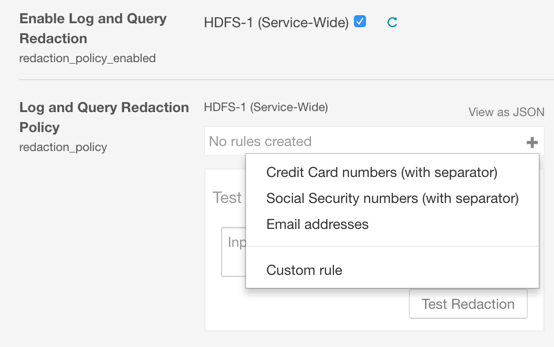Cloudera Manager and Passwords
- In the Cloudera Manager Admin Console:
- In the Processes page for a given role instance,
passwords in the linked configuration files are replaced by
*******. - Advanced Configuration Snippet (Safety Valve) parameters, such as passwords and secret keys, are visible to users (such as admins) who have edit permissions on the parameter, while those with read-only access see redacted data. However, the parameter name is visible to anyone. (Data to be redacted from these snippets is identified by a fixed list of key words: password, key, aws, and secret.)
- In the Processes page for a given role instance,
passwords in the linked configuration files are replaced by
- On all Cloudera Manager Server and Cloudera Manager Agent hosts:
- Passwords in the configuration files in
/var/run/cloudera-scm-agent/processare replaced by********.
- Passwords in the configuration files in
Cloudera Manager Server Database Password Handling
/etc/cloudera-scm-server/db.properties, as shown in
this example:
# Auto-generated by scm_prepare_database.sh on Mon Jan 30 05:02:18 PST 2017 # # For information describing how to configure the Cloudera Manager Server # to connect to databases, see the "Cloudera Manager Installation Guide." # com.cloudera.cmf.db.type=mysql com.cloudera.cmf.db.host=localhost com.cloudera.cmf.db.name=cm com.cloudera.cmf.db.user=cm com.cloudera.cmf.db.setupType=EXTERNAL com.cloudera.cmf.db.password=password
Instead of using a cleartext password, you can use a script or other
executable that uses stdout to return a password for
use by the system.
During installation of the database, you can pass the script name to
the scm_prepare_database.sh script with the
--scm-password-script parameter. See Setup CM Database and Syntax SCM Prepare Database for details.
You can also replace an existing cleartext password in
/etc/cloudera-scm-server/db.properties by replacing
the com.cloudera.cmf.db.password setting with
com.cloudera.cmf.db.password_script and setting the
name of the script or executable:
| Cleartext Password (5.9 and prior) | Script (5.10 and higher) |
|---|---|
| com.cloudera.cmf.db.password=password | com.cloudera.cmf.db.password_script=script_name_here |
At runtime, if
/etc/cloudera-scm-server/db.properties does not
include the script identified by
com.cloudera.cmf.db.password_script, the system
looks for the value of
com.cloudera.cmf.db.password.


